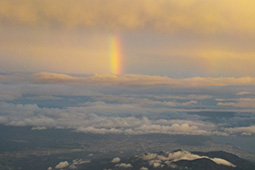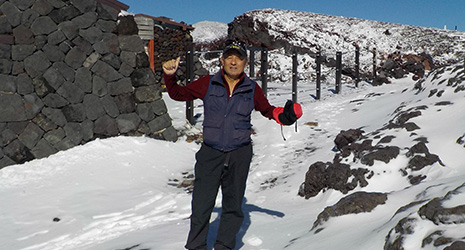
Mount Fuji 
A rainbow photographed by Jitsukawa from the summit of Mount Fuji
February 2021
Mr. Fuji-san

One man is so captivated by Mount Fuji, Japan’s highest mountain, that he has climbed it more than 2,000 times. They call him “Mr. Fuji-san” (Mr. Mount Fuji) and he is 77 years old.

Jitsukawa Yoshinobu, who will turn 78 in the summer of 2021, has reached the summit of the 3,776-meter Mount Fuji 2,060 times. Jitsukawa lives in the city of Numazu in Shizuoka Prefecture, at the southern base of Mount Fuji. He first climbed to the summit at the age of 42 with his family, and was impressed by the sea of clouds below. It was to be the first of many ascents of Mount Fuji.
Jitsukawa had loved the mountains ever since his childhood, going on to enjoy trekking and camping as a member of his company’s mountaineering club. Often, he would be asked by overseas trainees assigned to his company to drive them to the 5th station of Mount Fuji, from where they would climb toward the summit. Over repeated climbs of Mount Fuji, Jitsukawa felt himself increasingly captivated by the mountain. Today, he has stood on the summit of Mount Fuji 2,060 times, including one year when he made 248 ascents, and another year when he made two ascents a day for 75 consecutive days. The previous record for the most ascents was 1,672 held by a mountain guide who climbed Mount Fuji in prewar times. In 2011, Jitsukawa received a special commendation from the President of the Japanese Alpine Club on the occasion of his superhuman feat of reaching the summit 1,111 times.
“It was after I quit working that I started climbing to the summit twice a day. Another climber was amazed to see that the elderly man he had seen at the top in the morning was climbing from the 5th station again in the afternoon,” laughs Jitsukawa.
Jitsukawa’s “twice a day” climb goes like this. He drives from his home to the 5th station and starts climbing at around 8 a.m. It takes him around three hours to complete the first ascent and around an hour and a half to descend to the 5th station, where he has a quick lunch of rice balls or bread before heading back to the summit. Jitsukawa completes the two round trips in nine hours, whereas most climbers take two days to make one round trip with an overnight stay. In 2008, just after his retirement, he set a record for the most ascents in a year with 248. At that time, the Japanese baseball player Ichiro, who was active in the MLB (Major League Baseball) in the United States, was extending his record of consecutive 200-hit seasons and attracting a lot of media attention. Inspired by Ichiro’s record-setting achievements, Jitsukawa challenged himself to climb to the summit of Mount Fuji more than 200 times a year, which he did for six years in a row.

Jitsukawa also challenged himself to conquer the Seven Summits of the world, while continuing to climb Mount Fuji and approaching the mountain from different start points, such as beginning the walk at Tokyo Station or at the southern tip of the Izu Peninsula, and completing it without sleeping or resting. He finally made his 2,000th ascent in June 2018 at the age of 74.
“I’m the type of person who becomes obsessed with something once I take a shine to it. Mount Fuji is the world to me now. No matter how many times I climb it, the mountain looks completely different each time,” says Jitsukawa. The closure of Mount Fuji to hikers last year due to COVID-19 has meant his record of ascents remains at 2,060. Despite this, Jitsukawa remains in good spirits.
There are more than 340 mountains in all parts of Japan that in some way evoke Mount Fuji, each of them called by another name followed by “Fuji.” Examples include Mount Yotei, known as “Ezo Fuji” or “Yezo Fuji,” and Mount Rishiri, known as “Rishiri Fuji,” both in Hokkaido. Many are relatively easy to climb, and Jitsukawa says he is now planning to travel around Japan where these “Fuji” mountains are located. “I’d like to take my time traveling across Japan enjoying the ‘Mount Fujis’ of each region,” says Jitsukawa.

The shape of Mount Fuji resembles the kanji character hachi (“八”), meaning “eight.” The Japanese regard the shape of this figure as “sue-hirogari,” which literally means "spreading out like an unfolding fan” but has the meaning of “becoming prosperous.” When people look at Mount Fuji, this auspicious association only increases their admiration for the beauty of the mountain. Jitsukawa, for so long fascinated by Mount Fuji, is no exception.

